You'll find several effective natural perfume fixatives right in your kitchen cabinets. Common ingredients like vanilla extract (3-5% concentration), clove bud oil, and cinnamon oil can anchor your fragrances and extend their longevity. Dried citrus peels mixed with warming spices create potent aromatic compounds, while cardamom and myrrh add complexity to your blends. Store your creations in dark glass containers, and you'll discover how these eco-friendly alternatives rival commercial fixatives.
Understanding Kitchen Ingredients as Natural Perfume Fixatives
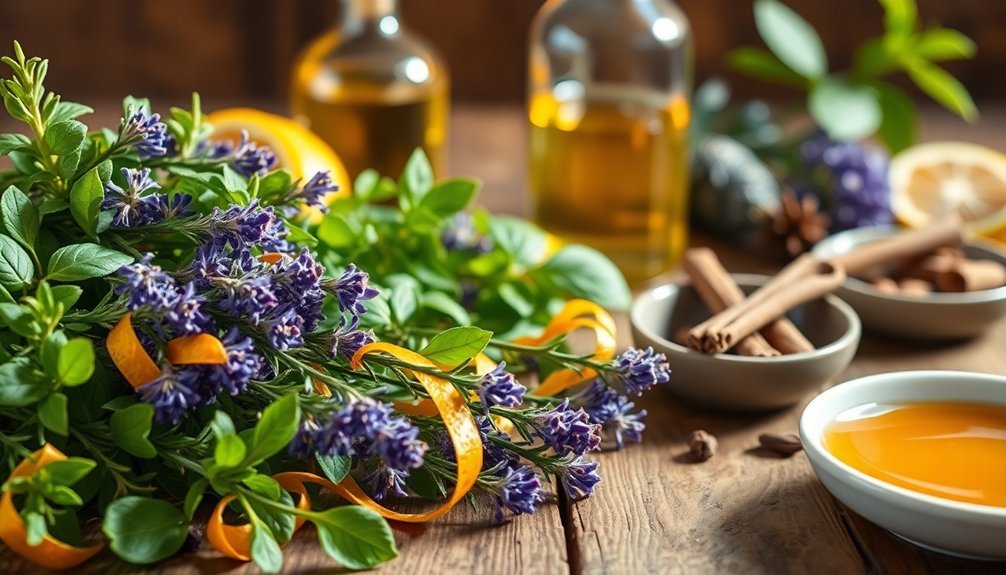
While commercial perfume fixatives can be expensive and hard to source, you'll find many effective natural alternatives right in your kitchen cabinets. You can draw inspiration from traditional perfumery's use of natural fixatives like resins and herbs to create your own eco-friendly solutions.
Just as perfumers use patchouli and clary sage for their earthy, stabilizing properties, you'll discover similar benefits in common kitchen ingredients. Many of these items work like professional fixatives by slowing down the evaporation of essential oils while adding depth to your fragrances. The increasing focus on high-quality product formulation has made natural fixatives more appealing to both DIY enthusiasts and manufacturers alike.
You're not just limited to traditional perfumery ingredients – you can experiment with natural substances that share similar properties to classic fixatives like benzoin and myrrh, making your perfume-making more sustainable and cost-effective.
Essential Spice Cabinet Fixatives for Long-Lasting Scents
Since many powerful fragrance fixatives naturally occur in common spices, your kitchen cabinet likely holds several ingredients that can extend the life of homemade perfumes.
You'll find that clove bud oil, with its pungent aroma, and cinnamon oil from bark both work exceptionally well to anchor other scents. For deeper complexity, you can incorporate cardamom oil's sweet spiciness or star anise's licorice-like notes.
If you're looking for more resinous options, consider adding myrrh or frankincense, which provide warm, smoky undertones while greatly improving longevity. These natural resins are especially effective at adding depth to oriental fragrances.
Benzoin offers a vanilla-like warmth that's particularly effective in oriental blends. You can also experiment with tulsi or clary sage to add an herbaceous dimension that helps lock in your desired fragrance profile.
Citrus-Based Fixative Methods for Homemade Perfumes

Building on spice-based fixatives, citrus fragrances present a unique challenge in natural perfumery due to their fleeting nature.
You'll find success by combining plant-based resins like benzoin and frankincense with your citrus oils, as they naturally extend the scent's longevity.
Try layering lemongrass and elemi essential oils with your citrus blend – they share similar profiles while offering better staying power.
For a more sustainable approach, skip animal-derived fixatives and opt for orange wax or orris root.
Pre-fixing your blend with resin material tinctures can significantly improve the overall longevity of your fragrance.
You can create depth by incorporating middle and base notes such as lavender and vanilla into your citrus blend.
Don't forget to let your perfume mature for several weeks after blending. This aging process allows the fixatives to properly bind with the citrus oils, resulting in a longer-lasting fragrance.
Vanilla Extract: The Ultimate Kitchen Fixative
Vanilla extract stands as a powerhouse fixative that you can easily source from your kitchen cabinet. You'll find it particularly effective in DIY perfumes at a 3-5% concentration, where it helps anchor lighter notes while adding depth to your blend. When creating natural fragrances, vanilla extract equalizes vapor pressures and extends the life of essential oils, offering a sweet, earthy foundation.
| Application | Benefit |
|---|---|
| Textiles | Prolongs fragrance life on fabrics |
| Perfumes | Slows evaporation of volatile compounds |
| Dyes | Acts as eco-friendly color fixative |
| Pest Control | Natural deterrent in crop protection |
| Essential Oils | Stabilizes and extends longevity |
Beyond perfumery, you can use vanilla extract to fix scents in textiles, protect crops naturally, and reduce chemical waste in fabric manufacturing, making it a versatile eco-friendly choice for multiple applications.
Creating Herbal Oil Infusions for Perfume Stability
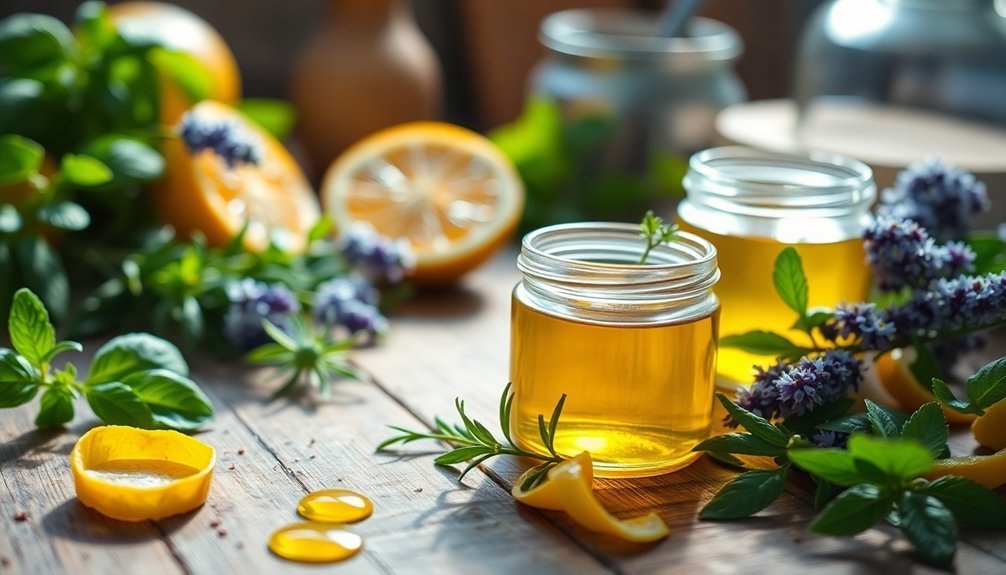
Creating long-lasting natural perfumes requires mastering the art of herbal oil infusions. You'll need to select herbs with proven fixative properties, such as orrisroot, labdanum, or patchouli, which help anchor your fragrance's volatile compounds.
To prepare your infusion, steep your chosen herbs in neutral grape or grain spirits for one month, using 1 gram of herbs per liter of alcohol. Store the mixture in a cool, dark place during maceration.
After filtering, blend the infused alcohol with carrier oils like jojoba or sweet almond at a 3-5% concentration.
Don't skip the maturation process – let your infused oils age for 30 days. Test your creation on perfume blotters and different skin types to verify it performs well.
Remember that fixatives not only extend wear time but also add complexity to your perfume's overall aroma profile.
Combining Kitchen Fixatives for Enhanced Longevity
Despite common misconceptions, kitchen ingredients don't serve as effective perfume fixatives on their own.
You'll need to look beyond your pantry for truly lasting fragrance enhancement.
Instead of experimenting with kitchen ingredients, you'll get better results by combining natural fixatives from specialized suppliers.
Start with a base of tonka bean, vanilla, or orris root, then blend with plant resins like labdanum or benzoin.
You can strengthen the fixative properties by adding essential oils such as patchouli or vetiver at a 3-5% concentration.
To create an effective blend, mix your chosen fixatives in a 1:1:1 ratio of base, heart, and top notes.
Let your mixture rest for 24 hours to allow proper integration.
This approach will give you the lasting fragrance you're seeking while maintaining eco-friendly standards.
Storage and Shelf Life of Kitchen-Based Fixatives
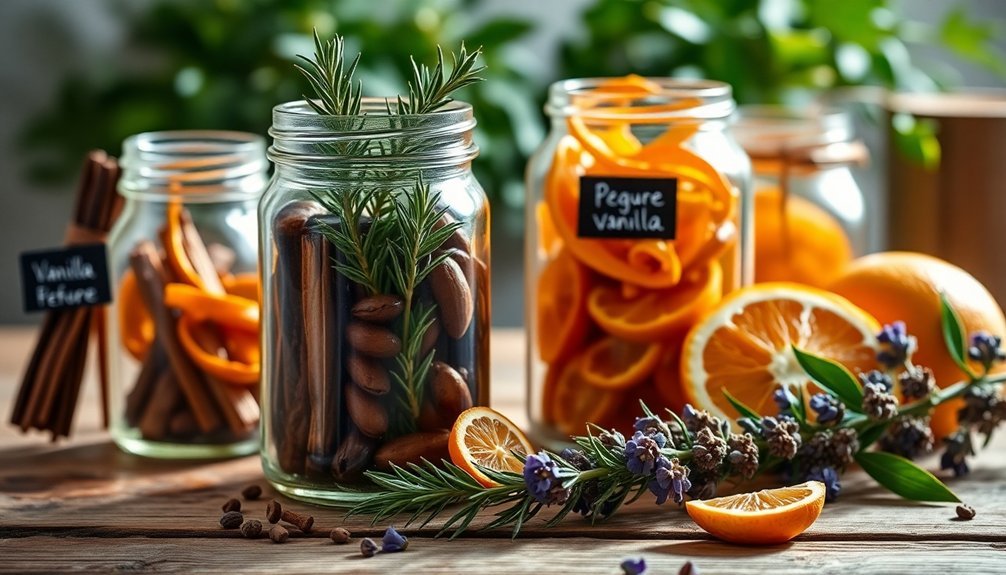
While natural fixatives enhance fragrance longevity, proper storage determines their ultimate effectiveness. You'll need to protect your fixatives from environmental factors that can greatly reduce their shelf life.
Store them in airtight, dark-colored glass containers in a cool, dark place away from heat sources and windows.
- Keep detailed records of each batch, including creation date and storage observations
- Test your fixatives every few months to monitor scent changes and consistency
- Store in areas with low humidity to prevent oxidation and degradation
- Use only high-quality, pure ingredients to guarantee better stability
- Avoid mixing incompatible ingredients that could trigger unwanted chemical reactions
With proper storage, your DIY perfume fixatives can last several years. Regular monitoring helps you track any changes in quality and adjust storage conditions as needed.
Measuring and Blending Kitchen Fixatives Effectively
To achieve consistent results with kitchen-based fixatives, you'll need precise measurements and careful blending techniques. Use a pipette or measured eyedropper to control your portions accurately, aiming to under-measure rather than over-measure your ingredients.
Start by measuring your fragrance oils at appropriate concentrations – stay under 20% for heavier scents and up to 30% for lighter ones.
When adding your kitchen fixatives, maintain ratios between 0.1% and 50%, depending on their potency. You'll want to blend these in a suitable solvent like ethanol, leaving enough space in your container for thorough mixing.
Test small batches first to guarantee compatibility and desired strength. You can adjust the blend by adding more diluent or fixative until you've achieved the perfect balance of scent persistence and character.
Sustainable Alternatives to Commercial Perfume Fixatives
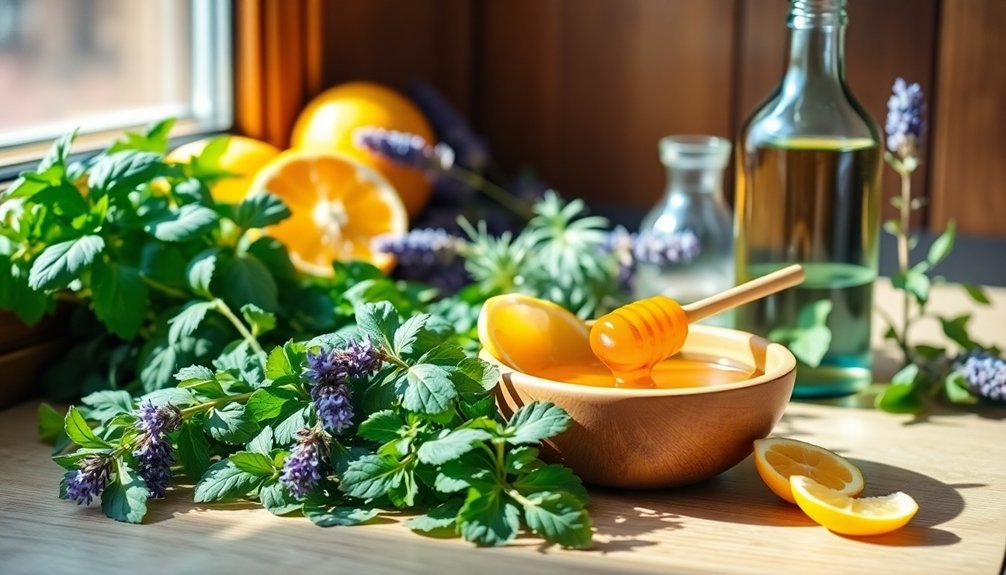
As perfume makers shift away from traditional synthetic fixatives, an array of sustainable alternatives has emerged from both natural and eco-conscious synthetic sources.
You'll find these options aren't only environmentally responsible but also offer excellent fragrance-fixing properties.
- Ambroxan provides a rich, ambergris-like scent without harming marine life
- Plant-based benzoin and labdanum deliver warmth and depth while supporting sustainable agriculture
- Essential oils like patchouli and vetiver serve as natural fixatives while adding earthy complexity
- Synthetic musks like Galaxolide and Fixolide offer clean, lasting scents with minimal environmental impact
- Iso E Super enhances longevity while maintaining a subtle, woody profile
When choosing fixatives for your perfumes, consider these sustainable options that protect both your fragrance's integrity and our planet's resources.
Time-Tested Kitchen Fixative Recipes and Applications
You'll find vanilla extract's natural fixative properties work best when blended with spices like cinnamon or cardamom, creating a rich base for homemade perfumes.
For a vibrant citrus-spice infusion, combine fresh orange or lemon peels with whole cloves and star anise in a carrier oil, letting them steep for at least two weeks.
These kitchen-sourced fixatives not only extend your perfume's longevity but also add complex, natural undertones to your fragrance blends.
Vanilla Extract Blending Tips
While vanilla extract serves as a beloved kitchen staple, it's also a powerful natural fixative for creating long-lasting perfumes. When blending vanilla extract into your homemade fragrances, you'll find it adds both stability and depth to your compositions while extending their longevity on the skin.
- Mix vanilla with sea salt accords for a unique summer fragrance that stays fresh throughout the day.
- Combine vanilla absolute with beeswax and natural oils to create a moisturizing fixative balm.
- Layer vanilla with floral notes for feminine scents, or woods and musks for masculine blends.
- Use Madagascar vanilla for a creamy, cedar-like undertone, or Tahitian vanilla for dark, complex depth.
- Blend vanilla with other fixatives like benzoin or frankincense to enhance the staying power of essential oils.
Citrus-Spice Infusion Methods
Creating your own citrus-spice fixatives starts with readily available kitchen ingredients that pack powerful aromatic compounds.
You'll want to combine dried citrus peels with warming spices like cinnamon, black pepper, or bay leaves in a base of high-proof alcohol or neutral oil.
Start by finely grinding your dried citrus peels and spices, then infuse them in your chosen base for several weeks.
You can enhance the blend by adding complementary essential oils like bergamot or lime.
For best results, strain the mixture through a coffee filter to remove any sediment, then add a touch of glycerine to lock in the scent.
This natural fixative method works particularly well for creating fresh, long-lasting fragrances that combine bright citrus notes with deep, spicy undertones.
Frequently Asked Questions
Can Kitchen-Based Fixatives Trigger Allergic Reactions When Used in Perfumes?
Yes, you can experience allergic reactions from kitchen ingredients in perfumes. Even common items like citrus peels or spices can trigger skin sensitivity, though they won't effectively fix scents like proper perfume fixatives.
How Do Natural Fixatives Interact With Synthetic Fragrance Oils?
You'll find that natural fixatives help stabilize synthetic fragrance oils by slowing their evaporation rate. They'll anchor the scent molecules, enhance longevity, and can add depth to your fragrance while maintaining its core profile.
Does Skin Ph Affect the Performance of Kitchen-Derived Perfume Fixatives?
Yes, your skin's pH considerably affects how kitchen-derived fixatives perform. You'll notice that acidic skin weakens their holding power, while neutral to slightly alkaline pH helps them anchor fragrances more effectively.
Can Kitchen Fixatives Stain Clothing When Used in Homemade Perfumes?
Yes, your kitchen fixatives can stain clothing, especially if you're using oil-based ingredients like vitamin E or olive oil. You'll want to apply these perfumes to your skin rather than directly on fabrics.
Do Natural Fixatives Lose Effectiveness When Exposed to Direct Sunlight?
Yes, you'll find that natural fixatives considerably lose their effectiveness when exposed to direct sunlight. They'll undergo photodegradation, which breaks down their molecular structure and reduces their ability to hold fragrances effectively.
In Summary
You've discovered that your kitchen holds the key to creating natural, long-lasting perfumes. By using common ingredients like vanilla extract, citrus peels, and aromatic spices, you'll reduce your environmental impact while enjoying unique, personalized scents. Don't hesitate to experiment with different combinations of these sustainable fixatives – you're not just making perfume, you're participating in an age-old tradition of natural fragrance creation.

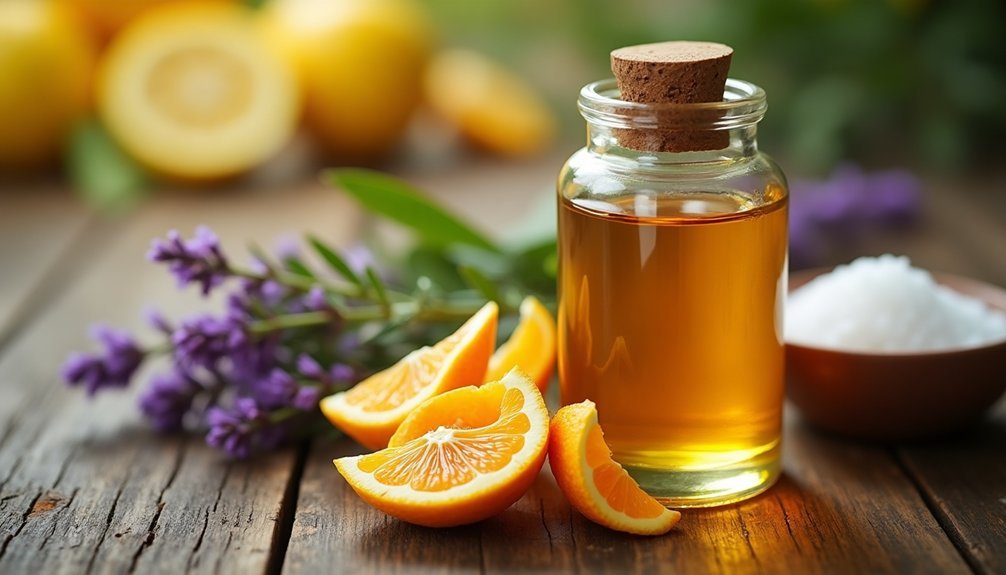
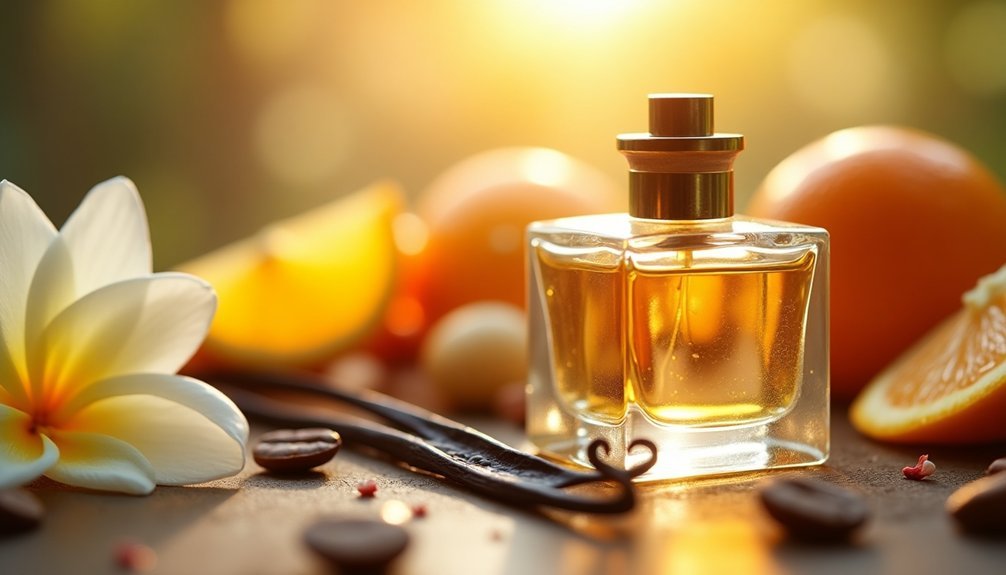

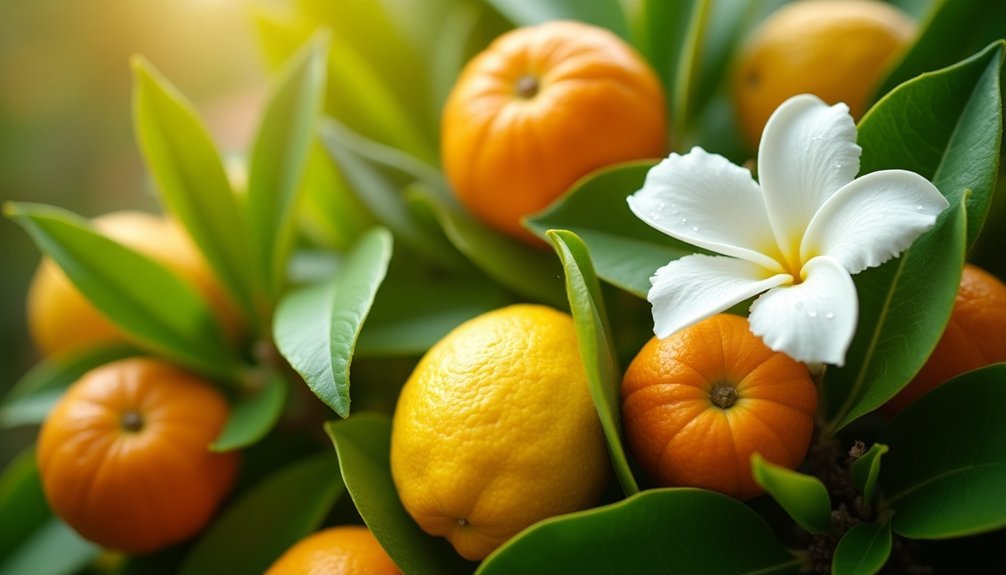
Leave a Reply